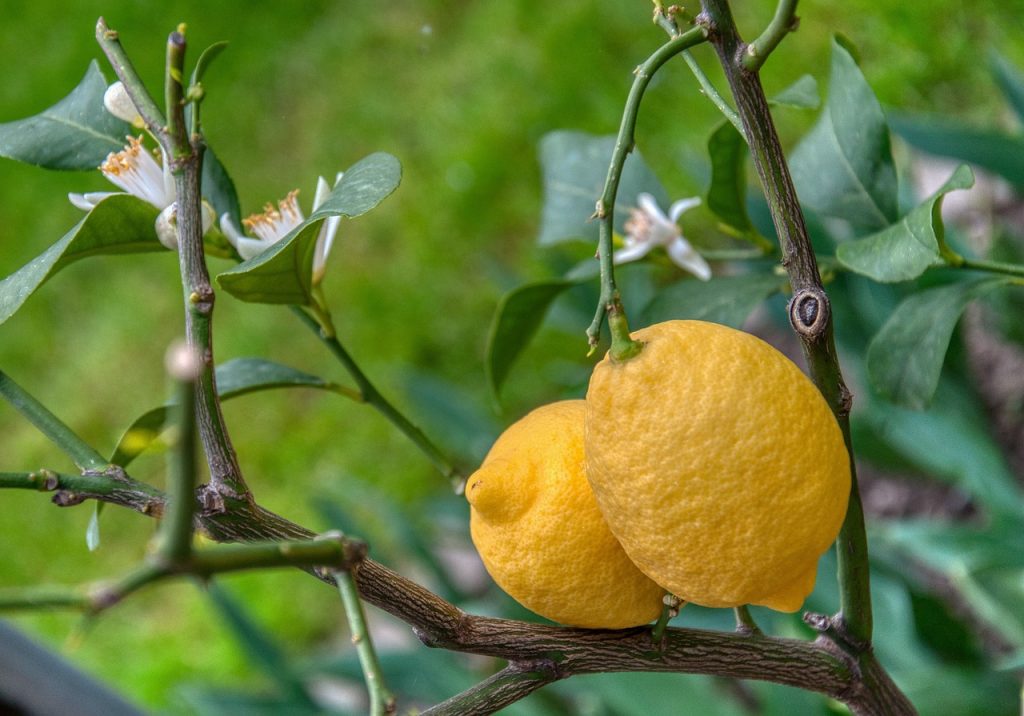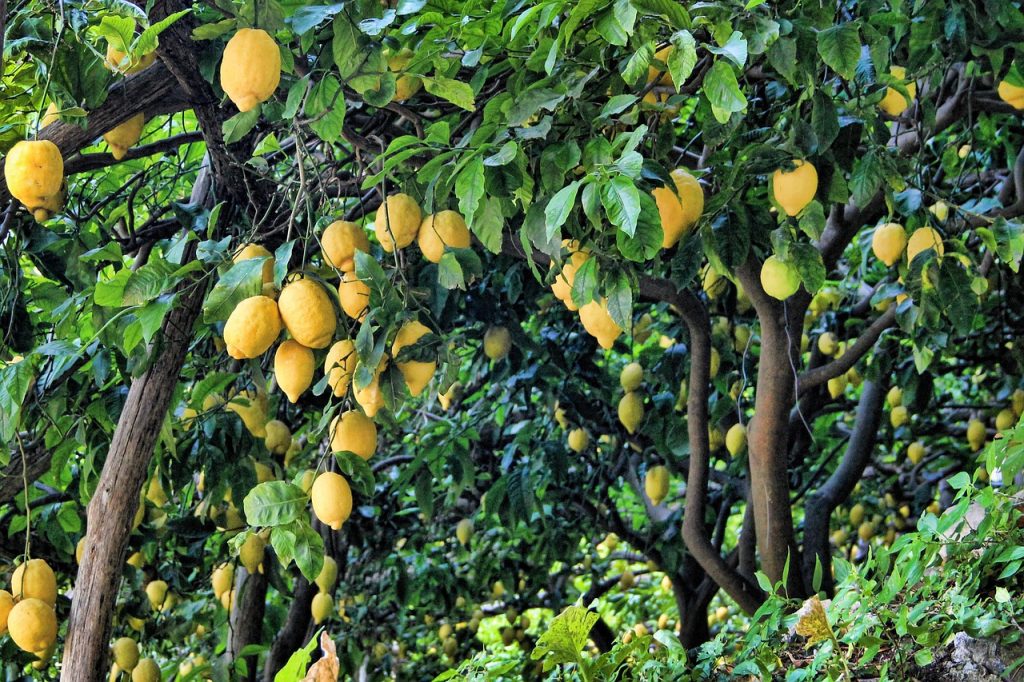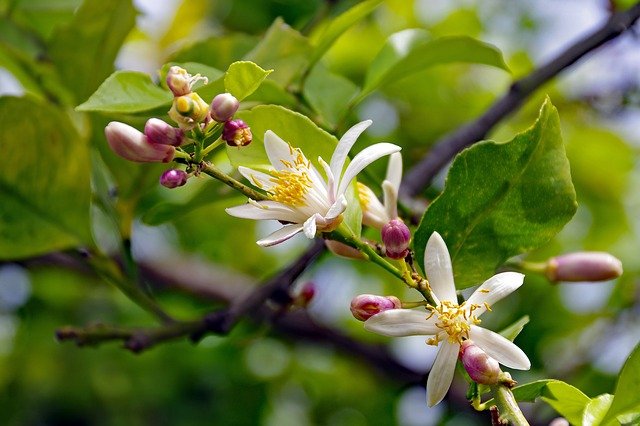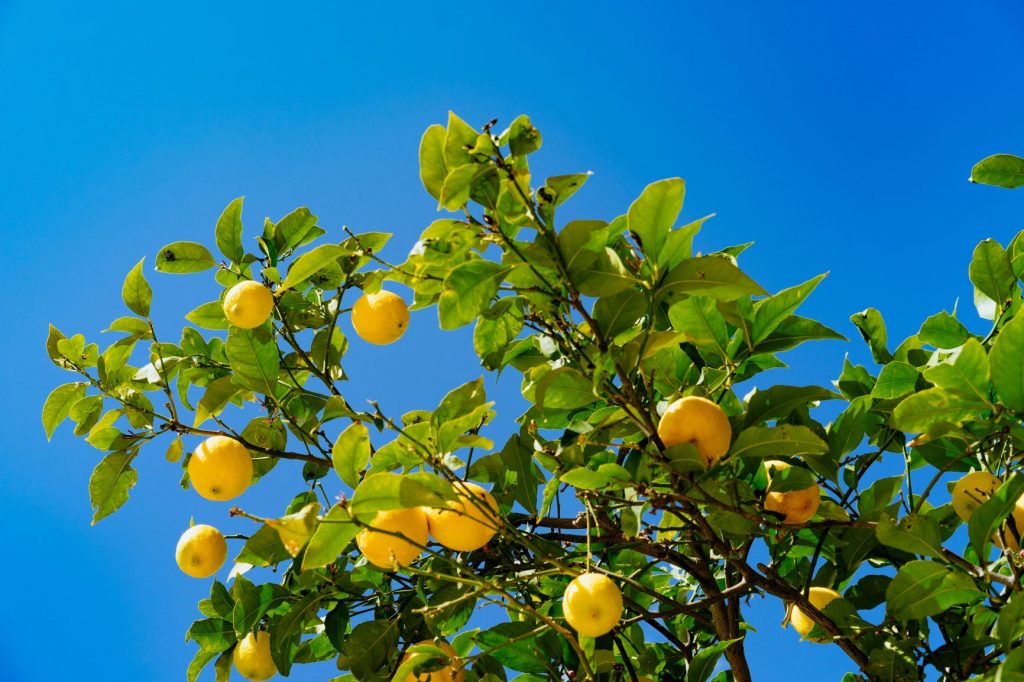Find out how to grow a lemon tree at home. Have you ever been to the grocery store and seen lemons advertised for a dollar apiece – or more? What if I told you my lemon tree currently holds over 75 lemons in various stages of ripening on my backyard tree? And while they’re ripening over the following weeks and months, the tree will continue to produce new blossoms and fruit for years to come. You might even say money really does grow on trees! Have you ever wondered how to grow a lemon tree? Well, now you too can grow your very own lemon tree, with prolific fruit, in your backyard at home.

A lemon tree is an amazing addition to the productive, food-producing backyard garden. While they can, of course, be planted as a purely decorative tree (think potted Mediterranean courtyard), they are most prized for their fruit. A squeeze of lemon juice on fish, a splash in a refreshing glass of cold water or drizzled over sprinkled sugar on freshly made crepes as my family indulged in for brunch this morning, lemons bring the zing when it’s needed.

Table of Contents
Ideal Growing Conditions
The lemon tree (botanical name Citrus limon) is believed to originate from India’s east on the Himalayan Mountains before being introduced to southern Italy and spreading throughout the Mediterranean.
Growing lemon trees are best in temperate to tropical climates where temperatures are ideally 70-85F (21-30C) with mild winters. Temperatures tipping 104F (40C) or below 30F (-1C) for extended periods of time will negatively impact the growth of the tree.
They are a small evergreen tree, ranging in height from 10-20ft (3-6m). Dwarf varieties are smaller at 5-16ft (1.5-5m).
Lemon trees prefer fertile, well-drained soil but will grow in less than ideal soil types.
As a sun-loving tree, they need to be planted in a sunny spot to receive at least 8 hours of sun a day. They do not like strong winds, so a protected position should be chosen.
Being self-fertile, lemon trees will produce fruit without needing cross-pollination from another lemon tree. However, they do benefit from visiting bees, other beneficial insects as well as a small amount of breeze, which all contribute to higher fertilization and a bigger lemon crop.
6 Steps To Plant A Lemon Tree
Step 1. Dig a hole twice the width of the lemon tree container and a little deeper than the container size. Planting holes can be prepared with some compost, though it’s important not to add any fertilizer as it can burn sensitive roots.
Step 2. Remove the tree from its pot and gently tease out the bottom roots of the lemon tree before planting.
Step 3. Place the tree in the hole, ensuring it is planted only up to the top of the root ball and no deeper.
Step 4. Fill the hole with soil and gently pat it down.
Step 5. Water the newly planted lemon tree well.
Step 6. Finish with a cover of 1-2inches (3-5cm) of organic mulch to retain moisture, leaving a small gap around the trunk.
When To Plant A Lemon Tree

Depending on your climate, lemon trees can be planted in spring or fall and sometimes all year round. For protection from heat or cold, plant in spring or fall. In the sub-tropics and tropics, plant in winter.
Water Requirements
Once established, lemon trees are moderately drought tolerant. In fact, it’s a good idea to allow the soil to partially dry between watering. Over-watering has the potential to cause the roots to rot.
Watering between rainfall every 7-10 days during the warm summer months will ensure a healthy tree with prolific fruit production. During the cooler months, times between watering can be extended.
Water newly planted lemon trees every second day for the first week or two and then twice a week until established.
Feeding Your Lemon Tree
As with most citrus trees, lemon trees are hungry and require regular feeding. Feed them with an organic citrus fertilizer 3-4 times a year. Lemon trees are big producers of fruit, so feed them well and they will reward you!
Lemon Tree Varieties
The humble Lemon Tree has come a long way from the gnarled looking trees of years gone by. Today, they make a beautiful feature tree in the backyard. The flowering blossoms are wonderfully scented and in the right climate, some varieties of lemon tree will fruit year-round.
Some of the more popular varieties are:
Eureka – This lemon produces a true sour-tasting lemon. The fruit is high in acid and juice, while the skin is medium to thick and fruit is large in size. Eureka is one of the worlds most widely grown lemon trees.
Lisbon – Similar tasting and quality of Eureka though the skin is thin. This lemon is productive and a vigorous growing tree (and thorny). Lisbon is the most cold-hardy lemon.
Meyer – A hybrid lemon (a cross between a lemon and an orange), produced to reduce acidity and sourness. Meyer lemon is a popular choice for the home-garden and its fruit make an excellent addition in the kitchen. You can purchase your own Dwarf Meyer Lemon Tree here.
Lemon Trees Grown in Pots and Containers
Lemon trees can do very well in pots and containers. They require a closer eye on the water requirements as they can dry out more quickly than garden-grown trees.
When growing lemon trees in pots, consider a dwarf lemon tree or find a variety that does well by being kept pruned under 2m. Growing a Meyer lemon tree is a good choice for pots.
They will need a pot or container large enough to allow room for growth.
The benefit of pot and container-grown lemon trees is that they can be moved into the sunniest position outside or brought indoors for winter in climates that freeze. They will still need plenty of light and possibly the addition of grow-lights if there is inadequate natural light. Keep them well-watered, but free-draining and fertilize as required.
Time To Fruit

Lemon trees will fruit when they are 3-5 years old. In many cases, garden centers and nurseries stock lemon trees when they are already a few years old. Usually, it is 2-3 years after planting before a new lemon tree fruits however your tree may produce a small number of lemons in its very first season.
To promote a strong and healthy lemon tree, it is recommended that any fruit produced in the first year or two be removed. This is to allow the new lemon tree to put all its energy into growing strong branches, rather than producing fruit. However, if the lemon tree branches look strong and healthy enough to bear the weight of the fruit, it would be perfectly okay to leave a few of the fruit on the tree to reach maturity.
In the right conditions and with the right care, a lemon tree can live for 50-100 years.
Harvesting Lemons
Depending on the variety and the growing conditions, from flowering to harvest, lemons can take from 4-12 months.
You will know the fruit is ripe when the color changes all over. Fruit can often be left on the tree for a while once ripe. However, they will eventually deteriorate and drop off the tree.
If largish fruit falls from the tree before they have fully ripened (often due to unfavourable conditions such as high wind or lack of water), lemons can still be edible. Given them a squeeze to check they have some give. If so, cut them open and if they look healthy, they’re good to use.
There are so many ways to use lemons, from squeezing over seafood, adding to salad dressing, and one of my all-time favorites – making up a batch of delicious Lemon and Lime Cordial!
Pruning

Prune off dead or diseased wood as well as any crossing branches. Other than that, there is no particular need to prune your lemon tree except to keep it at a manageable height and width.
Pruning more than 20 per cent will affect the next season’s harvest, so prune lightly unless there is a good reason.
Propagating
There is an art to producing a lemon tree. The varieties generally grown in backyards and orchards have been grafted on to disease-resistant rootstock. This process can take up to three years before they become available for sale in garden centers and nurseries.
While a lemon tree can grow from a seed, cutting or air-layering, there is no way to guarantee the fruit quality. Meanwhile, the tree can be susceptible to disease, root rot and ultimately disappointment.
Young grafted lemon trees are relatively inexpensive to purchase (remember they can live 50-100 years) and because they are already a few years old, fruiting time will be much quicker.
Pests and Disease
Citrus trees can be affected by pests or disease at some point. Here are a few to look out for:
Aphids
Leaf miner – read more about control in our article Citrus Leaf Miner Control: Natural And Organic Methods.
Scale
Sooty Mold
Stink Bugs (or bronze orange bugs). Stink bugs can wreak havoc on your lemon tree, leaving you with juiceless lemons and diminished lemon crops. However, there are some highly effective and natural methods to remove stink bugs from lemon trees. You can read more in our article Natural Remedies To Remove Stink Bugs From Citrus Trees.
Caterpillar
Fruit Fly
Related: Why Is My Lemon Tree Dying?
Conclusion
Picking lemons from your own lemon tree at home is so rewarding, not to mention convenient. Caring for your tree can be easy and by following a few guidelines detailed throughout this article, you will be harvesting lemons for years to come. And if you love your lemons, don’t just plant one tree, why not plant two?
Recommended Products
Further reading:
- How to Grow Avocados Indoors – And Will They Fruit?
- Growing Feijoa Pineapple Guava Trees and Eating Feijoa Fruit
- How to Grow Kumquats: Complete Guide To Kumquat Tree Care
- How To Grow Sensational Strawberries At Home
- Pepino Melon: How To Grow The Plant And Eat The Fruit
- How To Easily Grow Blueberries At Home
- How To Grow Key Limes For Key Lime Pie
- Why Is My Lime Tree Dying? Causes and Solutions
- Why Is My Lemon Bitter? Answered!
- Why Are My Oranges So Small? Causes and Solutions

